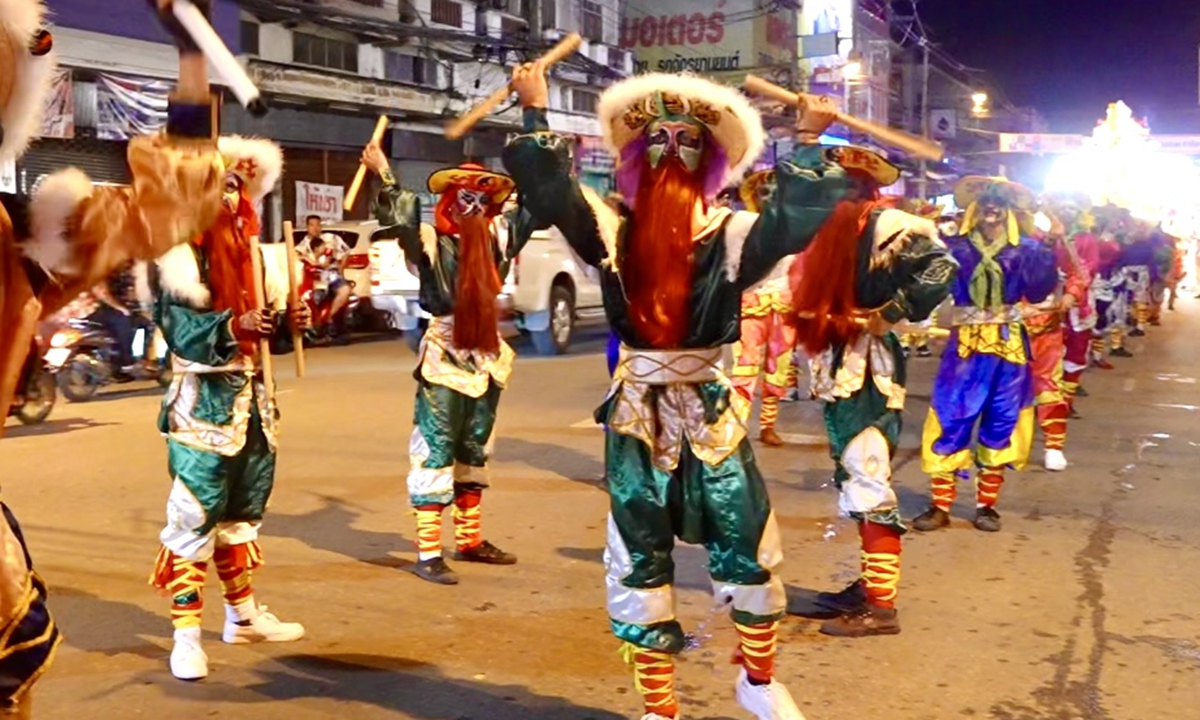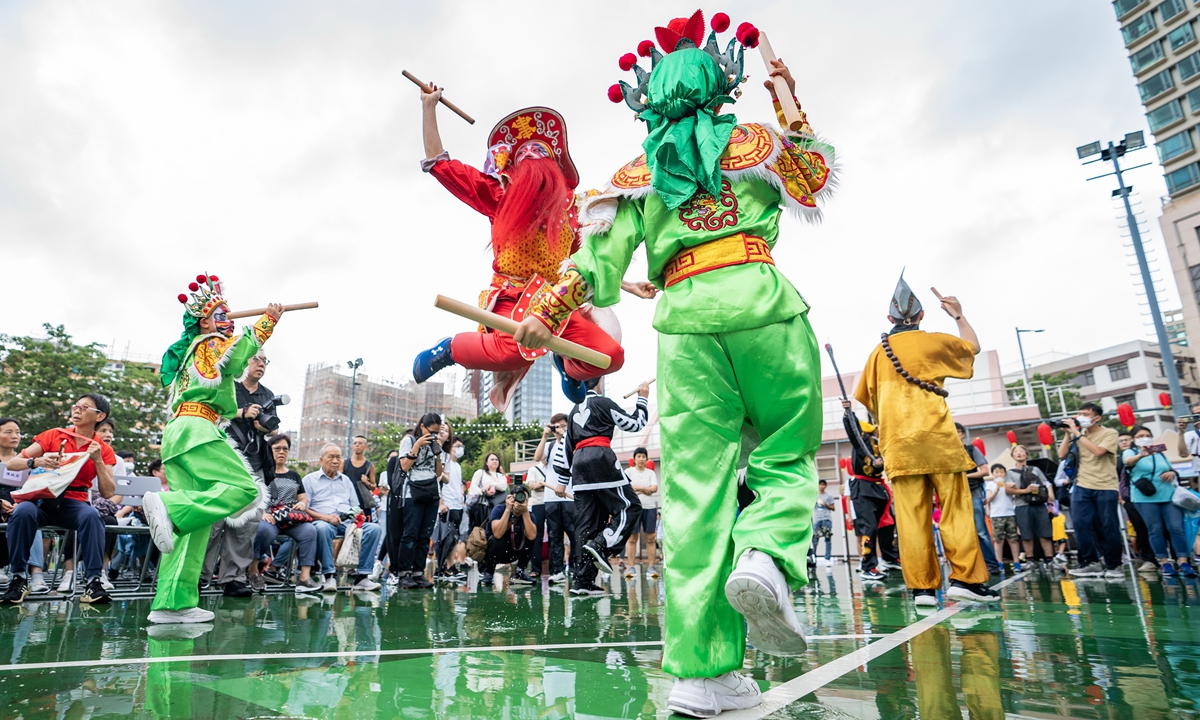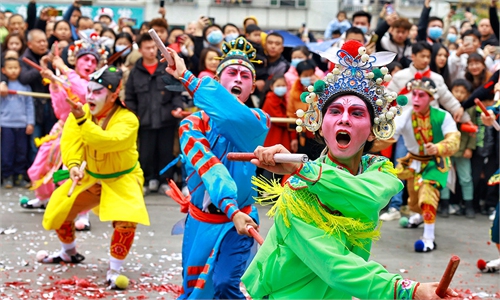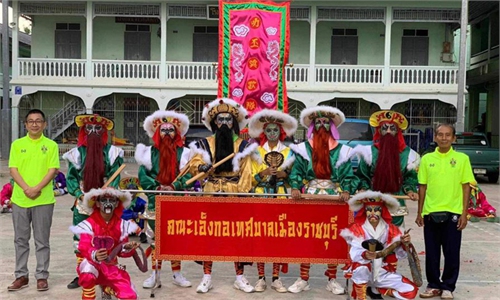ARTS / CULTURE & LEISURE
Historic reunion of traditional dance witnesses China-Thailand folk friendship
Way back home

Yingge dancers perform in Thailand. Photo: Courtesy of Deng Yao
A cultural exchange delegation from Thailand that practices Yingge, a traditional folkdance originating from China, is expected to visit the Chaoshan region of South China's Guangdong Province on Thursday.
A century ago, Yingge, literally the Songs of Heroes in Chinese, was introduced to Thailand by Chinese migrants and flourished, spreading to more than 10 provinces. Now, exponents of the dance in Thailand are making trips to China with the support of both governments.
Wei Xiuqian, principal of the Wenyi Public School in Phanat Nikhom, Chonburi Province in Thailand, told the Global Times that the delegation will be headed by the town's mayor Vijai Amaralikit and consists of 39 representatives from various fields including charities, businesses, Yingge coaches and performers, as well as school teachers.
"The oldest is over 70 years old and the youngest is 16. They will interact with the schools and Yingge teams in Shantou and Puning, watch Yingge shows, and perform with Chinese Yingge practitioners together," Wei said. Both Shantou and Puning are cities in Chaoshan, the cradle of Yingge.
Scholar and participant Deng Yao, who has devoted himself to the intangible cultural heritage of Guangdong Province, facilitated a visit by two young people from the Puning Fumei Youth Yingge Team to the Yingge teams in Chonburi and Udon Thani, in June 2023. Since mid-2022, Deng has been doing field research of the development of Yingge dance across Thailand.
Following the June trip, the Shantou cultural exchange delegation again traveled to Thailand in July to meet the mayor and Yingge team representatives, and both sides expressed a desire to facilitate more two-way visits and exchanges.
"The visit of the Chinese local government cultural exchange delegation directly set up an official channel for Yingge exchanges between the two countries, and stimulated a strong aspiration for Thai Yingge to return home," Deng said.

Dancers perform the Yingge dance. Photo: VCG
Second home for YinggeDuring the Mid-Autumn Festival of 1942, a Chinese person surnamed Luo organized a formal Yingge performance in Phanat Nikhom. In 1947, Zhang Keshan, another Chinese national, established a Yingge team in Nakhon Sawan, and staged performances during the Chinese New Year and Mid-Autumn Festival celebrations every year afterward. Later, Yingge dance became a popular feature of the Mid-Autumn Festival and Spring Festival performances. In the 1950s and 1960s, many Thai provinces with relatively large ethnic Chinese communities established Yingge teams, developing the inheritance of Yingge in Thailand.
Nowadays, Yingge has spread all over Thailand, particularly in Chonburi Province, Nakhon Sawan Province and Udon Thani Province.
The development of Thai Yingge is also changing with the times. During the 2023 Mid-Autumn Festival, Deng experienced a different Chinese traditional festival in Thailand.
The streets were awash with people who milled about incense cases, gongs and drums, lanterns, lion dances, and golden dragons.
The Mid-Autumn Festival, with a distinctively rich Chinese flavor, was a major attraction to local people and tourists alike. Thai traditional songs and dances were played and performed alongside Western music, giving the typically traditional Chinese festival an exotic feel.
But the most popular attraction of that night's festive offerings was still Yingge dance. "Perhaps the Chaoshan people thousands of kilometers away would think it strange that in a town of 120,000 people, there were three Yingge teams performing on Mid-Autumn Festival night, and two of them were elementary school Yingge teams," Deng recalled.
"I have never seen such a lively Mid-Autumn Festival in China! The first time I saw Yingge dance live was in Thailand," a Chinese volunteer teacher who recently graduated from the Guangdong University of Foreign Studies told Deng.
Thai Yingge has a strong Chinese traditional cultural color, and the flags, gongs and drums, costumes and straw hats of the Yingge teams all have traditional Chinese cultural elements.
People-to-people exchanges
The COVID-19 pandemic slowed global tourism, but Yingge dance has been used by local governments in Thailand as a means to revive the tourism economy.
Since November 2022, Phanat Nikhom has arranged Yingge performances in the open air every weekend, attracting tourists and stimulating consumption. The county also developed a Yingge Culture Experience One-Day Tour project, using Yingge to promote tourism.
On October 1, Udon Thani Province also held a Yingge Marathon Fun Race, attracting the participation of many local residents and foreign tourists.
In recent years, Deng has been studying the development and innovation of Yingge. Throughout 2022, Deng embarked on five special Yingge trips to Thailand, going deep into places including Chonburi and Udon Thani, following Yingge and listening to the stories of people who have inherited and developed this culture with Chinese origins.
"With the spread of videos and reports from Chinese media outlets, Thai Yingge has now been transmitted back to its hometown, arousing the curiosity of the Chaoshan Yingge people, and also awakened the nostalgia and longing of the Thai Chinese and young people who love Yingge," said Deng.
Deng Yao, senior attorney of the Cultural Heritage Public Welfare Law Center at Lifang & Partners, contributed to the story


